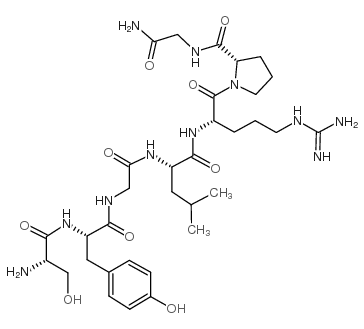LHRH (4-10) acetate salt
Modify Date: 2025-08-25 15:50:22

LHRH (4-10) acetate salt structure
|
Common Name | LHRH (4-10) acetate salt | ||
|---|---|---|---|---|
| CAS Number | 51776-33-1 | Molecular Weight | 747.84200 | |
| Density | N/A | Boiling Point | N/A | |
| Molecular Formula | C33H53N11O9 | Melting Point | N/A | |
| MSDS | N/A | Flash Point | N/A | |
Use of LHRH (4-10) acetate saltLH-RH (4-10) is a heptapeptide, one of major degradation products of luteinising-hormone releasing hormone (LHRH) via pituitary and hypothalamus. LH-RH (4-10) produced in macrophages and type II pneumocytes[1]. |
| Name | 1-[2-[[2-[[2-[[2-[(2-amino-3-hydroxypropanoyl)amino]-3-(4-hydroxyphenyl)propanoyl]amino]acetyl]amino]-4-methylpentanoyl]amino]-5-(diaminomethylideneamino)pentanoyl]-N-(2-amino-2-oxoethyl)pyrrolidine-2-carboxamide$GLP-HIS-TYR-SER-LEU-GLU-TRP-LYS-PRO-GLY-NH2 |
|---|---|
| Synonym | More Synonyms |
| Description | LH-RH (4-10) is a heptapeptide, one of major degradation products of luteinising-hormone releasing hormone (LHRH) via pituitary and hypothalamus. LH-RH (4-10) produced in macrophages and type II pneumocytes[1]. |
|---|---|
| Related Catalog | |
| In Vitro | The formation of LHRH 4-10, LHRH 7-10, and LHRH 6-10Co-incubation are inhibited by known enzyme inhibitors including Captopril (HY-B0368) (an ACE inhibitor), Thiorphan (HY-W013375) (an EP24.11 inhibitor), and Ethylenediaminetetraacetic acid (HY-Y0682) (an EP24.15 inhibitor)[1]. LH-RH (4-10) inhibits the binding of 125I-labeled GnRH to monoclonal antibody P81662 with an IC50 value of 23 pM[2]. |
| Molecular Formula | C33H53N11O9 |
|---|---|
| Molecular Weight | 747.84200 |
| Exact Mass | 747.40300 |
| PSA | 337.28000 |
| LogP | 0.21070 |
| InChIKey | ASNHUSJQZWXBOG-UHFFFAOYSA-N |
| SMILES | CC(C)CC(NC(=O)CNC(=O)C(Cc1ccc(O)cc1)NC(=O)C(N)CO)C(=O)NC(CCCN=C(N)N)C(=O)N1CCCC1C(=O)NCC(N)=O |
| Hazard Codes | T |
|---|---|
| Risk Phrases | 60 |
| Safety Phrases | 53-22-36/37/39-45 |
| WGK Germany | 3 |
| Ser-Tyr-Gly-Leu-Arg-Pro-Gly-NH2 |
| Luteinizing hormone releasing hormone Fragment 4-10 |
| LH-RH Fragment 4-10 |
| LHRH (4-10) |
| H-Ser-Tyr-Gly-Leu-Arg-Pro-Gly-NH2 |